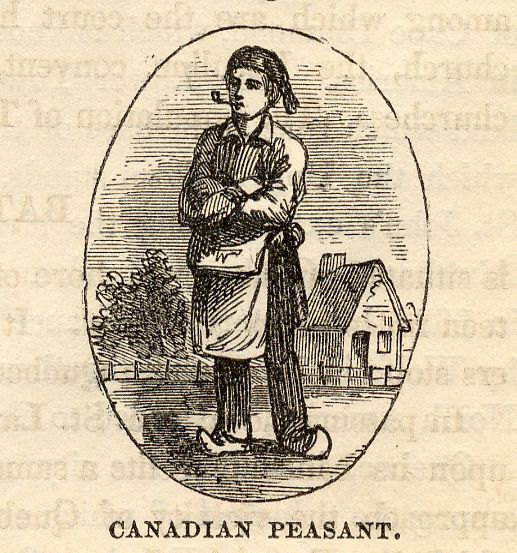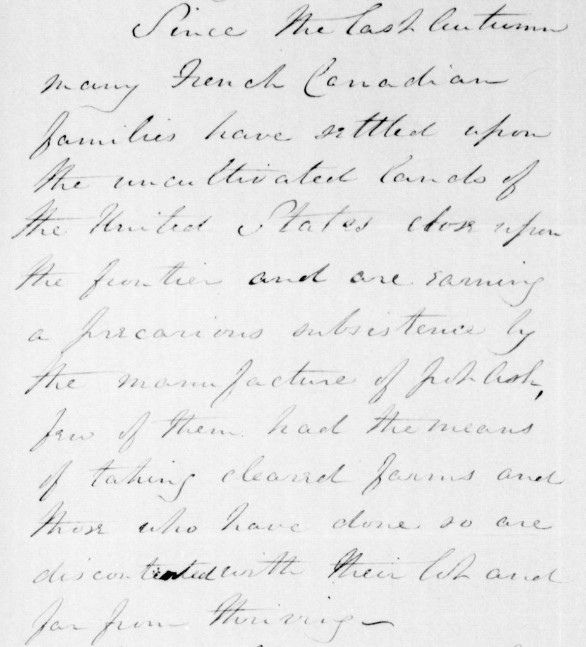In the last blog post, we considered how Lower Canadian agriculture may or may not have traversed a period of crisis in the first half of the nineteenth century. Historians still debate whether the colony experienced a sustained production crisis. The challenges were unquestionably many, however: soil exhaustion; fluke climatic events; fluctuating demand in Britain and increasing competition from other parts of North America; the tribulations involved in the introduction of new implements and new agronomic methods; economic pressure exerted by landlords; etc. In short, farming in the St. Lawrence River valley evolved—and did so under considerable pressure.
As for a crisis, the leanest years were undoubtedly those of the 1830s, though wheat and potato failures began at the end of the 1820s and stretched well into the 1840s. This period of scarcity overlapped with the first large burst of emigration to the United States, but we should not—as some scholars have done—simply ascribe this migration movement to agricultural hardship. Other factors help make sense of the “great hemorrhage.”
The first of these is demographic. Serge Courville and Normand Séguin state in Le monde rural québécois au XIXe siècle that Lower Canada’s population nearly doubled between from 1815 to 1840. Immigration was a factor, but natural growth accounted for the greatest share of that rapid growth. In principle, this would entail a scarcity of resources. Because aggregate agricultural acreage did not double, we might conclude, from math alone, that per capita fortunes fell. But, as we will see, the math must include changing techniques, crops, and yields; the fluctuating value of agricultural products; opportunities outside of Lower Canada; and the fate of related sectors within the colony.

Naturally, access to land was also part of the equation. We know from Allan Greer’s work on the lower Richelieu and Yamaska rivers that established households’ fortunes did not necessarily fall in this period. However, parents had to find ways of settling their children economically—no small problem if the plot could only support one family and available land in the old oikumene was scarce.
Colonization would become an ideological pet project in the second half of the century. Yet, well before then, people were expanding into the outlying regions of Lower Canada. We must remember, in fact, that in the 1840s, French Canadians were not migrating to the United States exclusively. They pushed into the Saguenay–Lac-Saint-Jean region, into the Upper St. John Valley, into the Eastern Townships, and so on. These ventures absorbed some young people. On the other hand, we have contemporary reports of French Canadians diving into the woods to make “civilization of wilderness”—and promptly becoming discouraged and seeking cold, hard cash in the United States. There is also something to suggest that in the prior generation or two, the tradition of défrichement had been lost in some regions. We can easily imagine why young men, from the warmth of their parents’ hearth, would have dreaded the prospect of building a farm from scratch, knowing the plot wouldn’t be productive for four years, which in turn meant delaying marriage and family formation for at least as long. Or yet, young men might work as farm laborers for much longer than their fathers had to amass the means of social and economic independence—and then settle for marginal lands. (The celebratory story of frontier settlement presented in Jean Rivard, discussed here and here, thus overestimated the sacrifices the common person was willing to make to preserve an agricultural way of life.)
All in all, the overall economic and social costs of agriculture rose, relative to its benefits, in the 1840s. Population growth helps explain that.

So, beyond agriculture, what could people do? Villages were growing, but opportunities in skilled trades still few. Further, by the 1810s, the heyday of the fur trade—at least as an economic engine in the East—had passed. Both demand and supply were factors. Labor needs steadily declined and much of the North American trade fell to U.S. interests led by John Jacob Astor.
Britain’s insatiable demand for lumber filled this void; British North America’s economy would still be organized around staples that served the metropole’s needs. From the Napoleonic Wars to the 1840s, the mast trade and ton timber were king. Quebec City thrived as a shipping port and shipbuilding center. Timber extraction moved farther and farther up river—it would come to define the economies of the Ottawa and Saint-Maurice river valleys and the Lac-Saint-Jean region. The trade needed workers, of course, and drew young men to camps during the winter, when the pace of activity on the family farm slowed. It is little wonder that in A Short History of Quebec, John Dickinson and Brian Young write of an integrated agroforestry system.
Access to such cold, hard cash came to a screeching halt in the 1840s. London had made the Canadian lumber industry—and London nearly destroyed it through changes in imperial trade policies. To put it concisely, policymakers created a climate of economic uncertainty by wavering on the all-important issue of imperial preference for colonial products. But the overall trend was towards free trade, which would put the Canadas in direct competition with the Baltic without the advantage of protective tariffs. With less money flowing into the colony, the livelihood of thousands was imperiled; merchants and lenders called their debts.
Donald G. Paterson and Ronald A. Shearer tell part of the story in their “Wheat, Railways and Cycles: The 1840s Reassessed.” They share a contemporary report that was reproduced in Toronto’s British Colonist:
Nearly eighteen months of unprecedented distress had prevailed within the province during which the system of all classes, from the largest merchant to the humblest labourer, had been paralyzed. The failure of the timber trade for some years past, the losses of the merchants at Montreal and Quebec, and the commercial panic in Europe, in 1847, had all seriously affected the monetary affairs of the province . . . bankers restricted their issues and not only refused their discounts, but urged imperatively the payment of their advances in all quarters. Thus the bankers pressed upon the wholesale merchants and they upon the middlemen and Storekeepers, who in their turn pressed equally upon their immediate debtors in all parts of the country . . .
The lumber trade would, in time, revive; it would again provide employment and secure the image of the draveur and legends like La chasse-galerie in Canadians’ cultural consciousness. But, aided by the Treaty of Reciprocity, much of this lumber would be destined for North American markets, particularly in the form of sawn lumber milled in Canada and the United States.
In case the agricultural and economic turmoil of the 1830s and 1840s hadn’t caused enough distress, we also have to take into account the Rebellions of 1837-1838—which erupted while bad harvests were endemic and at another time when credit was tightening. We often forget that the British response to the first insurrections, in November and December 1837, was mild. Whatever we might think of his later remarks, Lord Durham premised his short-lived regime on a quick return to normalcy, rather than retribution. Such would not be the case with the second round of rebellions. We have reports from the late 1830s and the 1840s that underscore military intimidation east and south of Montreal—and it is unclear what, exactly, of political or economic conditions, young men fled in those regions. The number of true political refugees in the United States was quite small, but it is no easy matter to disentangle politics from the economic reversals that drove thousands to the Great Republic from 1837 to 1840.

This all serves to confirm the intergenerational wealth disparity that Greer found in the 1820s, 1830s, and 1840s—a disparity that may have grown out of agriculture, but that was compounded by the larger economic landscape. Young people did not have the same advantages their parents or grandparents had experienced, difficult circumstances that might have been mitigated had other economic sectors developed and thrived.
This very brief tour d’horizon of push factors in Lower Canada cannot do justice to the extensive historiographical debates that have flourished since the 1960s. More than that—an additional note of caution—let’s remember that it does not suffice to look at migration only from the angle of push and pull factors. As we see from these two blog posts, this model can minimize human agency. To combat this and to challenge narratives of inevitability, scholars are increasingly studying migration through the lens of networks, that is, the connective tissue between points of departure and points of arrival. Public infrastructure, information networks, and kinship ties situate difficult human decisions in their technological and social context and can help us better understand “exceptional” migratory patterns.
In short, we should view agricultural woes and other macroeconomic phenomena as context rather than definite answers to when, why, how, and where French Canadians migrated.
Further Reading
My “Prelude to the ‘Great Hemorrhage’: French Canadians in the United States, 1775-1840” in the American Review of Canadian Studies (2021) discusses many of these challenges and the lure of the United States before the era of mass migration. I hope to expand upon this work by bringing the story up to the Civil War era.
Pingback: This week's crème de la crème - April 16, 2022 - Genealogy à la carteGenealogy à la carte